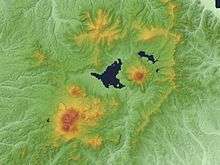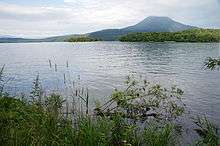Lake Akan
Lake Akan (阿寒湖, Akan-ko) is a lake in Kushiro, Hokkaidō, Japan. It is located in Akan National Park and is a Ramsar Site.[2][3]
| Lake Akan | |
|---|---|
The view from Mount Oakan (July 2008) | |
| Location | Kushiro, Hokkaidō, Japan |
| Coordinates | 43°27′6″N 144°5′55″E |
| Lake type | Dimictic |
| Native name | 阿寒湖 |
| Primary outflows | Akan River |
| Catchment area | 148 km2 (57 sq mi) |
| Basin countries | Japan |
| Surface area | 13 km2 (3,200 acres) |
| Average depth | 17.8 m (58 ft) |
| Max. depth | 44.8 m (147 ft) |
| Water volume | 0.23 km3 (0.055 cu mi) |
| Shore length1 | 25.9 km (16.1 mi) |
| Surface elevation | 420 m (1,380 ft) |
| Frozen | December to April |
| Islands | 4: Ōjima, Kojima, Yaitai Island, Chūrui Island |
| Settlements | Kushiro |
| Official name | Akan-ko |
| Designated | 8 November 2005 |
| Reference no. | 1540[1] |
| 1 Shore length is not a well-defined measure. | |


Lake Akan and Mount Oakan
History
Volcanic activity formed the lake some 6,000 years ago, when a dam was formed. The lake used to have a clarity of 8–9 meters in the 1930s. Pollution from local hotspring resorts has decreased the transparency to 3–4 meters.[4]
Flora and fauna
The lake is famous for the marimo (Aegagropila linnaei), aggregations of algae that form into spherical shapes 2–30 cm in diameter. Other flora of the lake include the following:[4]
- Phragmites communis
- Nuphar sp.
- Potamogeton crispus
- Hydrilla verticillata
- Myriophyllum verticillatum
- Vallisneria gigantea
- Melosira italica
- Asterionella formosa
- Synedra
Kokanee salmon (Oncorhynchus nerka) are native to Lake Akan. Other fauna of the lake include the following:[4]
- Zooplankton:
- Daphnia longiremis
- Bosmina coregoni
- Eurytemora affinis
- Bottom:
- Fish:
- Cyprinus carpio
- Carassius
- Hypomesus olidus
- Leuciscus hakonensis
gollark: ZWJ indents *are* the future and you cannot stop me.
gollark: I'm going to keep using zero width joiner indentation.
gollark: Try osmarks internet radio™.
gollark: GTech™ is manipulating the refractive index of the local air.
gollark: Did you know? It was already too late. The bees had approached. GTech™ dominion over reality had begun, and none could escape. One night the bees reached the horizon of the sun, and all the specks began. The swarms of specks, all over the city, and even over the whole town. It would be next year that the bees reached the horizon on the night of December 14, 2011. After a week of resting they came to the end of October. They were too exhausted to continue their journey even upon midnight. In the morning they returned to the city to continue their "trip" that came along with the plague. The evening afternoon after dawn, they crossed to the eastern edge of the city, and began their journey on the night of December 15th. The next day, the bees went on their trip to the west of the city. They went on their journey along the northern coast with an aeroplane. When they arrived in the coast of the east of the city, they had a night sleep, as they had not come along the northern coast any further.
See also
References
- "Akan-ko". Ramsar Sites Information Service. Retrieved 25 April 2018.
- "Data Summary: Akan-ko (Lake Akan)". World Lakes Database. International Lake Environment Committee. Archived from the original on 2012-04-20. Retrieved 2009-05-18.
- "Ramsar Sites in Japan - Akan-ko" (PDF). Ministry of the Environment. Retrieved 24 March 2011.
- "AKAN-KO (LAKE AKAN)". World Lakes Database. International Lake Environment Committee. Archived from the original on 2012-03-05. Retrieved 2009-05-18.
| Wikimedia Commons has media related to Lake Akan. |
This article is issued from Wikipedia. The text is licensed under Creative Commons - Attribution - Sharealike. Additional terms may apply for the media files.